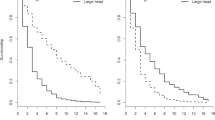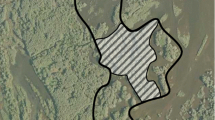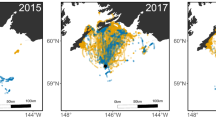Abstract
The optimal compromise between decision speed and accuracy may depend on cognitive ability, associated with the degree of encephalization: larger brain size may select for accurate but slow decision-making, beneficial under challenging conditions but costly under benign ones. How this brain size-dependent selection pressure shapes avian breeding phenology and reproductive performance remains largely unexplored. We predicted that (1) large-brained individuals have a delayed breeding schedule due to thorough nest-site selection and/or prolonged resource acquisition, (2) good condition facilitates early breeding independent of relative brain size, and (3) large brain size accrues benefits mainly to individuals challenged by environmental or intrinsic constraints. To test these predictions, we examined how the relative head volume of female eiders (Somateria mollissima) of variable body condition correlated with their breeding schedule, hatching success and offspring quality. The results were consistent with our predictions. First, large head size was associated with a progressively later onset of breeding with increasing breeding dispersal distance. Second, increasing body condition advanced the timing of breeding, but this effect was significantly weaker in large-brained females. Third, larger head volume was associated with increased hatching success mainly among late breeders and those in poor body condition, and duckling body condition was positively related to maternal head volume, but only in poor-condition mothers. Our study is, to our knowledge, the first to demonstrate the presence of brain size-related differences in reproductive strategies within a single natural population.






Similar content being viewed by others
References
Aiken LS, West SG (1991) Multiple regression: testing and interpreting interactions. Sage, Thousand Oaks
Allander K, Bennett GF (1995) Retardation of breeding onset in great tits (Parus major) by blood parasites. Funct Ecol 9:677–682
Blums P, Clark RG, Mednis A (2002) Patterns of reproductive effort and success in birds: path analyses of long-term data from European ducks. J Anim Ecol 71:280–295
Bolduc F, Guillemette M (2003) Human disturbance and nesting success of common eiders: interaction between visitors and gulls. Biol Conserv 110:77–83
Burns JG, Rodd FH (2008) Hastiness, brain size and predation regime affect the performance of wild guppies in a spatial memory task. Anim Behav 76:911–922
Cauchard L, Boogert NJ, Lefebvre L, Dubois F, Doligez B (2013) Problem-solving performance is correlated with reproductive success in a wild bird population. Anim Behav 85:19–26
Chittka L, Skorupski P, Raine NE (2009) Speed–accuracy tradeoffs in animal decision making. Trends Ecol Evol 24:400–407
Christensen TK (1999) Effects of cohort and individual variation in duckling body condition on survival and recruitment in the Eider Somateria mollissima. J Avian Biol 30:302–308
Clark RG, Shutler D (1999) Avian habitat selection: pattern from process in nest-site use by ducks? Ecology 80:272–287
Cole EF, Quinn JL (2012) Personality and problem-solving performance explain competitive ability in the wild. Proc R Soc Lond B 279:1168–1175
Cole EF, Morand-Ferron J, Hinks A, Quinn JL (2012) Cognitive ability influences reproductive life history variation in the wild. Curr Biol 22:1808–1812
Cooke F, Findlay CS, Rockwell RF (1984) Recruitment and the timing of reproduction in lesser snow geese (Chen caerulescens caerulescens). Auk 101:451–458
Deaner RO, Barton RA, van Schaik CP (2003) Primate brains and life histories: renewing the connection. In: Kappeler PM, Pereira ME (eds) Primate life histories and socioecology. University of Chicago, Chicago, pp 233–265
Descamps S, Bêty J, Love OP, Gilchrist HG (2011) Individual optimization of reproduction in a long-lived migratory bird: a test of the condition-dependent model of laying date and clutch size. Funct Ecol 25:671–681
Development Core Team R (2013) R: a language and environment for statistical computing. R Foundation for Statistical Computing, Vienna
Gonda A, Herczeg G, Merilä J (2013) Evolutionary ecology of intraspecific brain size variation: a review. Ecol Evol 3:2751–2764
Goudie RI, Roberston GJ, Reed A (2000) Common Eider (Somateria mollissima). In: Poole A, Gill F (eds.) The Birds of North America, No. 546. Birds of North America, Philadelphia
Healy SD, Rowe C (2007) A critique of comparative studies of brain size. Proc R Soc Lond B 274:453–464
Hoover JP (2003) Decision rules for site fidelity in a migratory bird, the prothonotary warbler. Ecology 84:416–430
Ings TC, Chittka L (2008) Speed-accuracy tradeoffs and false alarms in bee responses to cryptic predators. Curr Biol 18:1520–1524
Isler K, van Schaik CP (2009) The expensive brain: a framework for explaining evolutionary changes in brain size. J Hum Evol 57:392–400
Jaatinen K, Öst M (2011) Experience attracts: the role of age in the formation of cooperative brood-rearing coalitions in eiders. Anim Behav 81:1289–1294
Jaatinen K, Öst M (2013) Brood size matching: a novel perspective on predator dilution. Am Nat 181:171–181
Jaatinen K, Seltmann MW, Hollmén T, Atkinson S, Mashburn K, Öst M (2013) Context dependency of baseline glucocorticoids as indicators of individual quality in a capital breeder. Gen Comp Endocrin 191:231–238
Kilpi M, Lindström K (1997) Habitat-specific clutch size and cost of incubation in common eiders, Somateria mollissima. Oecologia 111:297–301
Koolhaas JM, de Boer SF, Coppens CM, Buwalda B (2010) Neuroendocrinology of coping styles: towards understanding the biology of individual variation. Front Neuroendocrin 31:307–321
Kotrschal A, Rogell B, Bundsen A, Svensson B, Zajitschek S, Brännström I, Immler S, Maklakov AA, Kolm N (2013) Artificial selection on relative brain size in the guppy reveals costs and benefits of evolving a larger brain. Curr Biol 23:168–171
Kotrschal A, Lievens EJ, Dahlbom J, Bundsen A, Semenova S, Sundvik M, Maklakov AA, Winberg S, Panula P, Kolm N (2014) Artificial selection on relative brain size reveals a positive genetic correlation between brain size and proactive personality in the guppy. Evolution 68:1139–1149
Kotrschal A, Corral-Lopez A, Amcoff M, Kolm N (2015) A larger brain confers a benefit in a spatial mate search learning task in male guppies. Behav Ecol 26:527–532
Logan CJ, Palmstrom CR (2015) Can endocranial volume be estimated accurately from external skull measurements in great-tailed grackles (Quiscalus mexicanus)? PeerJ 3:e1000
Mery F, Kawecki TJ (2003) A fitness cost of learning ability in Drosophila melanogaster. Proc R Soc Lond B 270:2465–2469
Møller AP (2010) Brain size, head size and behaviour of a passerine bird. J Evol Biol 23:625–635
Møller AP, Erritzøe J (2014) Predator–prey interactions, flight initiation distance and brain size. J Evol Biol 24:34–42
Opplinger A, Richner H, Christe P (1994) Effect of an ectoparasite on lay date, nest-site choice, desertion, and hatching success in the great tit (Parus major). Behav Ecol 5:130–134
Öst M, Steele BB (2010) Age-specific nest-site preference and success in eiders. Oecologia 162:59–69
Öst M, Jaatinen K (2015) Smart and safe? Antipredator behavior and breeding success are related to head size in a wild bird. Behav Ecol 26:1371–1378
Öst M, Wickman M, Matulionis E, Steele B (2008a) Habitat-specific clutch size and cost of incubation in eiders reconsidered. Oecologia 158:5–216
Öst M, Smith BD, Kilpi M (2008b) Social and maternal factors affecting duckling survival in eiders Somateria mollissima. J Anim Ecol 77:315–325
Öst M, Lehikoinen A, Jaatinen K, Kilpi M (2011) Causes and consequences of fine-scale breeding dispersal in a female-philopatric species. Oecologia 166:327–336
Parker H, Holm H (1990) Patterns of nutrient and energy expenditure in female common eiders nesting in the high arctic. Auk 107:660–668
Perrins CM (1970) The timing of birds’ breeding seasons. Ibis 112:242–255
Sih A, Del Guidice M (2012) Linking behavioural syndromes and cognition: a behavioural ecology perspective. Philos Trans R Soc Lond B 367:2762–2772
Sinnott RW (1984) Virtues of the haversine. Sky Telesc 68:159
Sol D (2009) Revisiting the cognitive buffer hypothesis for the evolution of large brains. Biol Lett 5:130–133
Trimmer PC, Houston AI, Marshall JAR, Bogacz R, Paul ES, Mendl MT, McNamara JM (2008) Mammalian choices: combining fast-but- inaccurate and slow-but-accurate decision-making systems. Proc R Soc Lond B 275:2353–2361
van Woerden JT, Willems EP, van Schaik CP, Isler K (2012) Large brains buffer energetic effects of seasonal habitats in catarrhine primates. Evolution 66:191–199
Verhulst S, Nilsson JA (2008) The timing of birds’ breeding seasons: a review of experiments that manipulated timing of breeding. Philos Trans R Soc Lond B 363:399–410
Wolak ME, Fairbairn DJ, Paulsen YR (2012) Guidelines for estimating repeatability. Methods Ecol Evol 3:129–137
Yokoi T, Fujisaki K (2009) Hesitation behaviour of hoverflies Sphaerophoria spp. to avoid ambush by crab spiders. Naturwissenschaften 96:195–200
Zuur AF, Ieno EN, Walker NJ, Saveliev AA, Smith GM (2009) Mixed effects models and extensions in ecology with R. Springer, New York
Acknowledgments
We thank Petteri Lehikoinen, Heikki Eriksson, James Montanari, Martin Seltmann, Sara Neggazi and Ben Steele for their assistance in the field. We thank Anders Møller for discussion and constructive comments, and two anonymous reviewers for their comments. Tvärminne Zoological Station provided excellent facilities. This study was funded by the Academy of Finland (grants no. 266208 to KJ and 128039 to MÖ), the Finnish Cultural Foundation (to KJ) and the Swedish Cultural Foundation in Finland (to MÖ).
Author contribution statement
KJ and MÖ conceived and designed the study and both authors collected the field data together. KJ analysed the data. KJ and MÖ wrote the manuscript.
Author information
Authors and Affiliations
Corresponding author
Additional information
Communicated by Indrikis Krams.
Electronic supplementary material
Below is the link to the electronic supplementary material.
Rights and permissions
About this article
Cite this article
Jaatinen, K., Öst, M. Brain size-related breeding strategies in a seabird. Oecologia 180, 67–76 (2016). https://doi.org/10.1007/s00442-015-3468-2
Received:
Accepted:
Published:
Issue Date:
DOI: https://doi.org/10.1007/s00442-015-3468-2




